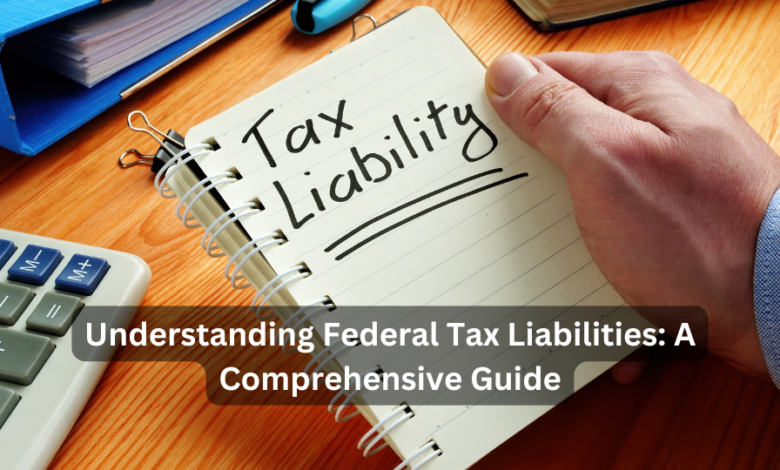Understanding Federal Tax Liabilities: A Comprehensive Guide

Federal tax liabilities are an essential concept for individuals and businesses alike, representing the total amount of tax owed to the U.S. government. Navigating federal taxes can be complex, but understanding the intricacies of tax liabilities can help you manage your finances effectively and avoid penalties. This article will dive deep into what federal tax liabilities entail, how they are calculated, the implications for individuals and businesses, and steps to minimize your tax burden.
What Are Federal Tax Liabilities?
Federal tax liabilities refer to the total amount of tax a person or business owes to the federal government. This liability arises from various income sources and business operations that are subject to federal taxation. When you file your tax returns with the IRS, your tax liability is the amount you must pay after accounting for deductions, credits, and other adjustments.
Types of Federal Taxes That Contribute to Tax Liabilities
There are several types of federal taxes that individuals and businesses may be liable for:
- Income Tax: This is the most common type of federal tax and applies to wages, salaries, investments, and other income sources.
- Payroll Taxes: Businesses are responsible for withholding Social Security and Medicare taxes from employees’ wages and contributing matching amounts.
- Corporate Taxes: Corporations must pay taxes on their profits, contributing to their overall tax liability.
- Capital Gains Tax: Tax on the profit from the sale of an asset such as stocks, real estate, or a business.
- Self-Employment Taxes: For those who are self-employed, Social Security and Medicare taxes are paid through self-employment tax.
Understanding the different types of taxes that contribute to your federal tax liability is crucial for effective tax planning and compliance.
How Federal Tax Liabilities Are Calculated
The calculation of federal tax liabilities depends on various factors, including income, deductions, credits, and the taxpayer’s filing status. Let’s break down the process of calculating federal tax liabilities for both individuals and businesses.
For Individuals
- Gross Income: The first step in calculating federal tax liabilities is determining gross income, which includes wages, dividends, interest, rental income, and other sources.
- Adjustments to Income: Certain deductions can reduce gross income to arrive at adjusted gross income (AGI). These adjustments may include retirement account contributions, student loan interest, and educator expenses.
- Standard or Itemized Deductions: Taxpayers can choose between the standard deduction or itemizing their deductions, such as mortgage interest, medical expenses, and charitable donations.
- Tax Credits: Credits such as the Child Tax Credit or Earned Income Tax Credit directly reduce tax liability, providing significant savings.
- Tax Rate: Once taxable income is determined, it is taxed at graduated rates based on your income bracket. The U.S. tax system is progressive, meaning higher income levels are taxed at higher rates.
- Payments and Withholdings: The amount of tax already withheld from your paycheck or made through estimated payments is subtracted from your tax liability to determine if you owe more or are due a refund.
For Businesses
Businesses have a more complex process of calculating tax liabilities, depending on their structure (e.g., C-corporation, S-corporation, partnership, or sole proprietorship).
- Gross Receipts: Businesses must calculate their total revenue from sales, services, and other income.
- Deductible Expenses: Operating expenses such as wages, rent, utilities, and cost of goods sold (COGS) are subtracted to arrive at net income.
- Depreciation and Amortization: Businesses can deduct depreciation of assets over time, reducing taxable income.
- Tax Credits: Similar to individuals, businesses can take advantage of tax credits, such as the Research & Development (R&D) Tax Credit or energy efficiency credits.
- Corporate Tax Rate: Corporations are taxed at a flat rate of 21% on profits, while other business structures pass income through to the owners, who are taxed at individual rates.
Consequences of Unpaid Federal Tax Liabilities
Failing to pay your federal tax liability can have serious consequences, including:
- Penalties and Interest: The IRS charges penalties for late payments, underpayments, or failure to file. Interest accrues on unpaid tax from the due date until the balance is paid in full.
- Tax Liens: If a tax liability remains unpaid, the IRS may place a tax lien on your property, meaning they have a legal claim to your assets.
- Wage Garnishment: The IRS has the authority to garnish wages or seize assets to satisfy outstanding tax debts.
- Legal Action: In extreme cases, the IRS may take legal action to recover unpaid taxes, including levying bank accounts or selling property.
To avoid these consequences, it’s crucial to pay your tax liability in full by the due date or set up a payment plan with the IRS.
Strategies for Reducing Federal Tax Liabilities
Reducing your federal tax liabilities requires careful planning and the use of available deductions and credits. Here are some strategies that can help individuals and businesses lower their tax burden:
1. Maximize Deductions and Credits
- Retirement Contributions: Contributing to retirement accounts like 401(k)s and IRAs can reduce taxable income.
- Health Savings Accounts (HSAs): Contributions to an HSA are deductible, and withdrawals for qualified medical expenses are tax-free.
- Education Credits: The Lifetime Learning Credit and American Opportunity Tax Credit can help offset the cost of tuition and other educational expenses.
2. Use Tax-Advantaged Accounts
Tax-advantaged accounts such as Flexible Spending Accounts (FSAs) and 529 College Savings Plans can help you save on taxes while planning for future expenses.
3. Business Expense Deductions
For businesses, taking full advantage of deductible expenses like home office deductions, vehicle expenses, and interest on business loans can significantly reduce tax liabilities.
4. Defer Income
Deferring income to the following tax year can help reduce your taxable income for the current year. This strategy is particularly useful if you expect to be in a lower tax bracket next year.
5. Take Advantage of Capital Gains Strategies
For investors, utilizing tax strategies such as tax-loss harvesting or deferring capital gains through a 1031 exchange can help minimize the tax burden on investment income.
How to Pay Your Federal Tax Liabilities
Once you have determined your federal tax liability, there are several ways to make payments to the IRS:
- Electronic Funds Withdrawal (EFW): You can pay directly from a checking or savings account when e-filing your return.
- IRS Direct Pay: This is a free service that allows individuals to pay their tax bill directly from a bank account.
- Credit or Debit Card: While this option is convenient, note that third-party providers may charge a processing fee.
- Installment Agreement: If you are unable to pay your full tax liability by the due date, you can set up a payment plan with the IRS.
- Check or Money Order: Payments can also be mailed to the IRS along with your tax return or payment voucher.
Federal Tax Liabilities for Non-Residents and Foreign Entities
For non-residents and foreign entities doing business in the U.S., federal tax liabilities can be complex due to international tax treaties and varying rules regarding source income. Non-residents are taxed on U.S.-sourced income, and there may be special reporting requirements for foreign assets or bank accounts through FATCA (Foreign Account Tax Compliance Act) and FBAR (Report of Foreign Bank and Financial Accounts).
Taxation of U.S. Income for Non-Residents
Non-residents are subject to U.S. taxes on income earned from U.S. sources. This includes wages, salaries, interest, dividends, and business income. However, tax treaties between the U.S. and other countries may offer exemptions or reduced tax rates for certain types of income.
Tax Reporting Requirements for Foreign Entities
Foreign corporations and other entities that earn income in the U.S. may be required to file Form 1120-F, the U.S. income tax return for foreign corporations. Additionally, they may need to report information about foreign ownership or activities through Form 5472.
Steps to Resolve Federal Tax Liabilities
If you find yourself with a large federal tax liability, there are several steps you can take to resolve it:
- Pay in Full: The simplest way to resolve a tax liability is to pay the full amount owed by the due date.
- Offer in Compromise (OIC): This program allows taxpayers to settle their tax debt for less than the full amount owed if they can prove they cannot pay the full liability.
- Innocent Spouse Relief: If your spouse incorrectly reported income or deductions, you may qualify for innocent spouse relief, which can help reduce your tax liability.
- Installment Agreement: If you cannot pay your liability in full, you can request a long-term payment plan through the IRS.
- Request a Penalty Abatement: If you’ve been charged penalties for failing to pay or file on time, you may be able to request a penalty abatement if you can show reasonable cause.
Conclusion
Understanding and managing your federal tax liabilities is critical to maintaining financial health and avoiding the penalties associated with unpaid taxes. Whether you’re an individual taxpayer or a business, keeping track of deductions, credits, and payment deadlines is essential. By employing smart tax strategies, staying compliant with IRS regulations, and addressing your liabilities promptly, you can minimize your tax burden and avoid the costly consequences of non-payment.
For more information on federal tax liabilities, visit the IRS website or consult with a qualified tax professional.


